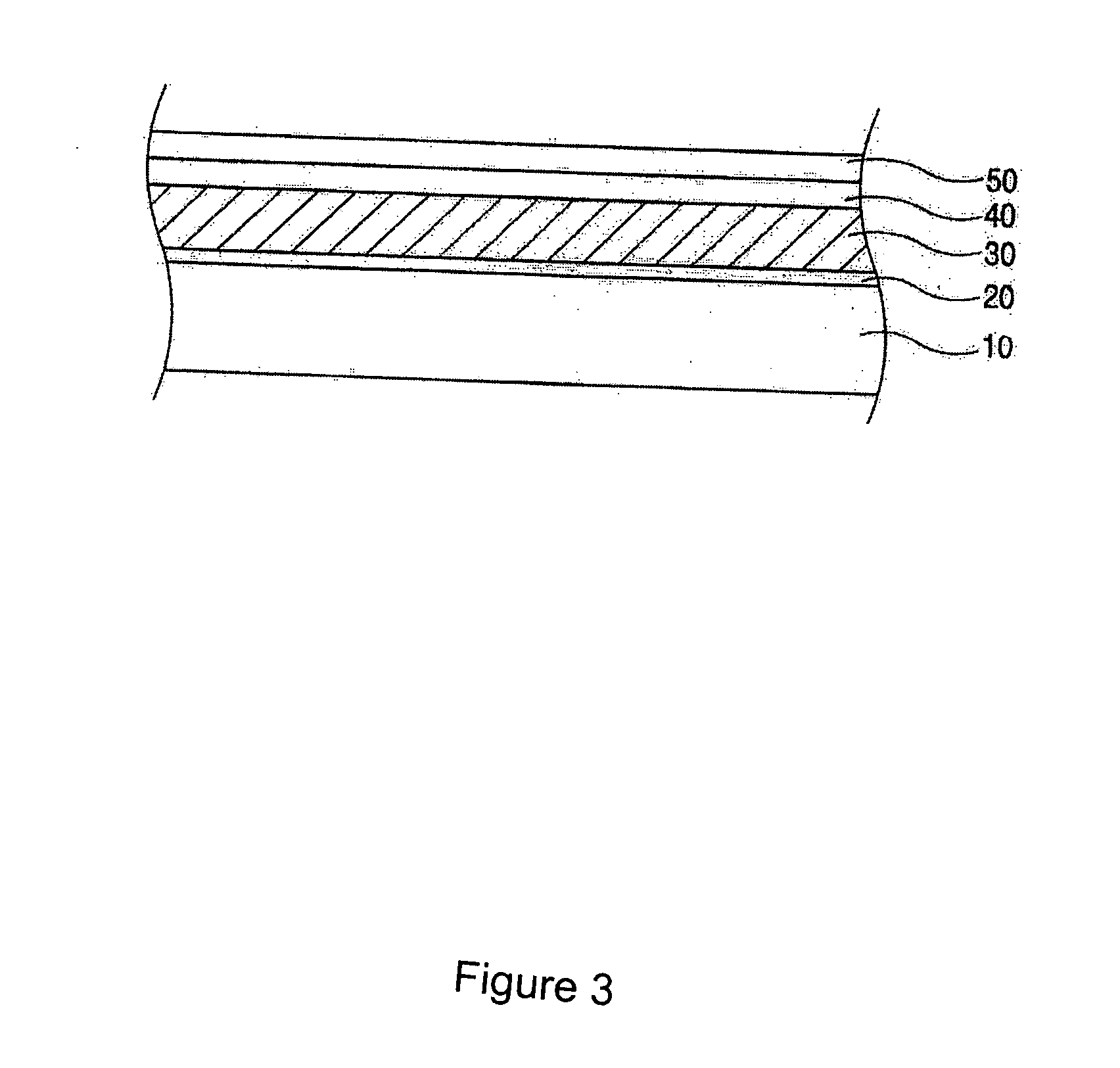Luminescent semi-conductive polymer material, method of preparing the same and organic light emitting element having the same
a semi-conductive polymer and polymer material technology, applied in the field of light emitting materials, can solve the problems of low emission intensity, undesirable bands, lack of mechanical strength,
- Summary
- Abstract
- Description
- Claims
- Application Information
AI Technical Summary
Benefits of technology
Problems solved by technology
Method used
Image
Examples
specific example 1
[0023] The polymerization of 1,3,5,7,8-pentamethyl-2,6-diethylpyrromethene difluoroborate complex (pyrromethene 567) was carried out by glow discharge at a temperature of about 250° C., at the discharge power of 0.5 W and a residual pressure of about 10−2 Pa for about 2 minutes. A polymer layer was deposited onto a substrate made of quartz glass having a conductive coating and then deposited onto one of the electrodes. The resultant layer had a thickness of about 0.01 μm, an electrical conductivity of about 1×10−10 S / cm, a luminescence maximum in a spectrum region in the range of about 540 nm to about 544 m with a half-width of the luminescence band in the range of about 55 nm to about 60 nm, and a quantum yield of photoluminescence of about 0.8.
specific example 2
[0024] A luminescent polymer material layer was prepared similar to Example 1, but using the following conditions. The polymerization was conducted at the temperature of about 350° C., the discharge power was about 3 W, the residual pressure was about 10−10 Pa and the duration time was about 120 minutes. The resultant layer was deposited on a silicon substrate placed on one of the electrodes and had a thickness of about 10 μm, an electric conductivity of about 5×10−10 S / cm, a luminescence maximum in a spectrum region in the range of about 575 nm to about 585 nm with a half-width of the luminescence band in the range of about 65 nm to about 75 nm, and quantum yield of photoluminescence of about 0.6.
specific example 3
[0025] A luminescent polymer material layer was prepared as in Example 1, but using the following conditions. The polymerization was carried out at a temperature of about 300° C., at a discharge power of about 1.5 W, at a residual pressure of about 5×10−2 Pa and with a duration time of polymerization of about 60 minutes. The resultant layer was deposited on metal substrate placed between the electrodes and had a thickness of about 5 μm, an electric conductivity of about 2×10−10 S / cm, a luminescence maximum in a spectrum region in the range of about 560 nm to about 570 nm with a half-width of the luminescence band in the range of about 60 nm to about 65 nm, and a quantum yield of photo-luminescence of about 0.68.
Organic Light Emitting Display (OLED) Apparatus
[0026] Referring to FIG. 3, which illustrates an embodiment of the present invention, the OLED apparatus comprises a glass substrate 10, an anode 20, a light emitting layer 30, a cathode 40 and a protecting layer 50. The anode...
PUM
| Property | Measurement | Unit |
|---|---|---|
| Temperature | aaaaa | aaaaa |
| Temperature | aaaaa | aaaaa |
| Temperature | aaaaa | aaaaa |
Abstract
Description
Claims
Application Information
 Login to view more
Login to view more - R&D Engineer
- R&D Manager
- IP Professional
- Industry Leading Data Capabilities
- Powerful AI technology
- Patent DNA Extraction
Browse by: Latest US Patents, China's latest patents, Technical Efficacy Thesaurus, Application Domain, Technology Topic.
© 2024 PatSnap. All rights reserved.Legal|Privacy policy|Modern Slavery Act Transparency Statement|Sitemap



